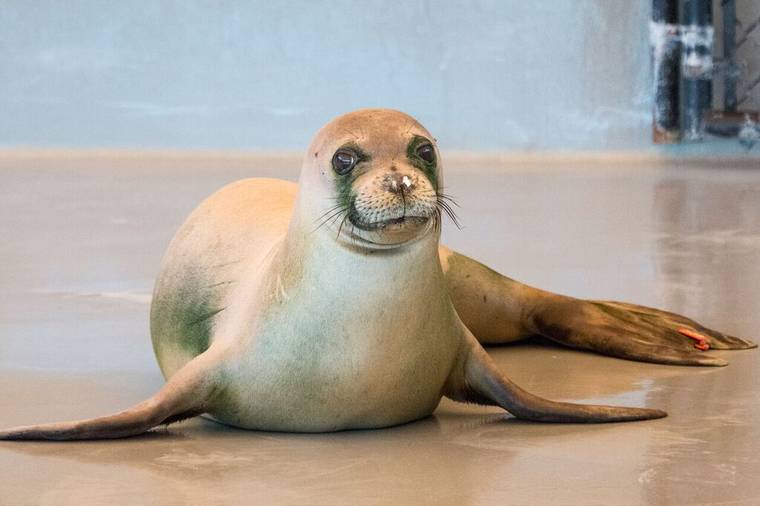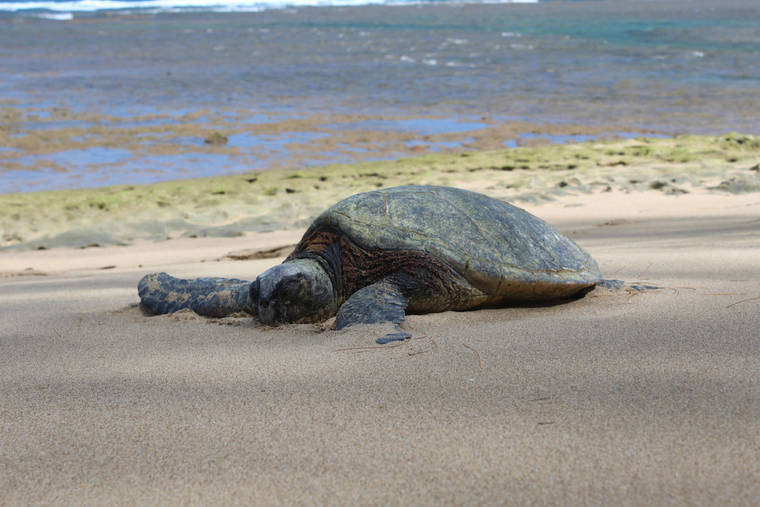Preserving plants and animals
LIHUE — Three little plants cling to the edge of a cliff in Kalalau Valley. They’re the only left of their species, thought to be extinct in 2016, and were discovered in January by scientists with the National Tropical Botanical Garden.
The plants were found using drone technology.
And while the critically endangered Hibiscadelphus woodii — related to the hibiscus, with its bright yellow flowers — is clinging to its cliffside life, it’s likely depending on native honeycreeper birds for pollination.
“Hibiscadelphus woodii grows as a shrub or small tree and produces bright yellow flowers which turn purplish-maroon as they age,” NTBG staff said in an April release about the discovery. “The nectar-rich flowers are likely pollinated by native honeycreeper birds including the amakihi.”
Amakihi is one of the honeycreepers that occurs throughout the Hawaiian Islands and is one of the several native birds under the umbrella of the Kauai Forest Bird Recovery Project. They focus on saving these bird populations, including three that are endemic to Kauai and listed as federally endangered — the ‘akeke’e, the‘akikiki and the puaiohi.
Studies — recently one published in the journal of Science Advances — are showing avian malaria and climate change are whittling away at these species.
Plants and forest birds aren’t the only endangered animals on Kauai — Hawaiian monk seals, green sea turtles, Newell’s shearwaters, and the nene goose are all on the list as well. Statewide, Hawaii is known as the endangered species capitol of the world.
Being on the ESA list has advantages for species recovery. Take the Hawaiian monk seal for instance, were listed under the ESA in 1976 after prolonged decline in population numbers. Since then, the population has begun to climb in the Northwestern Hawaiian Islands and in the Main Hawaiian Islands, due to recovery efforts triggered by the listing.
Latest data shows from 2014-2016 there was a three percent growth each year and “promising advances in juvenile seal survival enhancement research,” according to the National Oceanic and Atmospheric Administration.
An April study in the Journal PeerJ is acknowledging the importance of the ESA as well, which was passed by Congress in 1973. The study, published April 22, shows the Endangered Species Act has saved roughly 99 percent of protected wildlife under its umbrella.
“Congress passed the Endangered Species Act to stop more species like the Carolina parakeet and great auk from going extinct, and in the vast majority of cases, it has worked,” said Noah Greenwald, endangered species director at the Center for Biological Diversity and lead author of the study. “There can be no question that without the Endangered Species Act, we would have lost species like bald eagles, California condors, black-footed ferrets and many, many more.”
Relying on five-year status reviews by the U.S. Fish and Wildlife Service and other scientific data, the study identified and assessed the status of currently listed threatened or endangered species that may be extinct.
Of the more than 1,700 animals and plants protected under the Endangered Species Act, the authors found just four species that went extinct after receiving protection and another 22 that are possibly extinct. Another 71 are extinct or possibly extinct but were last seen before they were listed and protected, so the Endangered Species Act never had the chance to save them.
Those four species were the dusky seaside sparrow, Morro Bay kangaroo rat, Curtis’ pearlymussel and a Hawaiian plant called pamakani. The recently-discovered Hibiscadelphus woodii was on that “possibly extinct” list until its January discovery.
For comparison, the study found that a total of 291 species would have been expected to go extinct without the Endangered Species Act.
And while proponents of the ESA point out its success in preventing extinction and rehabilitating species, they say point out a 2016 study that shows dedicated funding for endangered species is roughly three percent of what is needed.
“The Endangered Species Act works incredibly well for protecting and recovering species, but it would work a lot better with sufficient funding,” said Greenwald. “If lawmakers in Congress really wanted to help recover wildlife, they could simply increase funding for species conservation.”
••• Jessica Else, environment reporter, can be reached at 245-0452 or at jelse@thegardenisland.com


